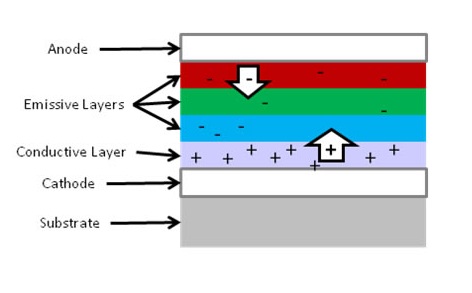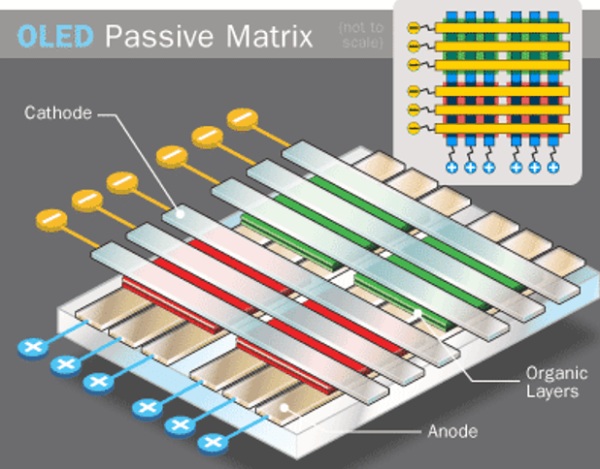The OLED display full form is (Organic Light Emitting Diode) display. It is a type of LED display technology that uses organic compounds to generate light. Unlike led-backlit LCDs, OLEDs emit their own light without an external backlight.
Eastman Kodak scientists invented OLEDs in the late 1980s. However, till the early 2000s, consumer electronics began to use this technology. Since then, OLED technology has kept on developing. Now, it’s becoming popular in flat-panel displays (FPD).
OLED displays have many advantages over other display technologies. They are thin, flexible, and energy-efficient. Meanwhile, their contrast and color accuracy are better than traditional LCDs.
This article will talk about the following:
- How OLED displays work,
- Their advantages and disadvantages,
- Their typical uses,
- And trends of this technology.
Page Contents
ToggleHow does an OLED display work?
OLED Display Structure
An OLED display consists of the following:
- An emissive electroluminescent layer, made of a thin film of organic compounds, emits light,
- Two electrodes deposited on the top and bottom substrate (glass or plastic), made of transparent conductive materials like Indium Tin Oxide (ITO), apply an electric current.

When an electric current goes through the emissive layer, it emits light.
Emissive Layer
The emissive layer is a key component of OLED. It gives off colored light. This layer’s organic materials are:
- Organic small-molecule electroluminescent materials,
- Polymer light-emitting diodes,
- Phosphorescent organic materials.
Each of these materials has its pros and cons.
The chemical composition of the organic materials determines the light’s color. And the total performance of OLED mostly depends on the efficiency and stability of the emissive layer.
Driving Circuit and Control System
The driving circuit and control system controls the voltage and current to the organic materials layer. Therefore, OLED displays can keep consistent brightness and color accuracy across the screen. And can also reduce power consumption.
The control system can also include features such as adaptive brightness control. Which can adjust the brightness in ambient light conditions.
Advantages of OLED display
OLED offers many advantages over traditional LCDs, including superior color accuracy, energy efficiency, and flexibility.
Contrast and Color Accuracy
High contrast and accurate color reproduction are OLED technology’s primary advantages. OLED displays can produce deeper blacks and brighter colors than LCDs. Therefore, they are applications like photography, video production, and gaming devices.
Thin and Flexible
Another advantage is their thin and flexible design. Flexible OLEDs are thinner and more flexible than LCDs because of no backlight requirement.
In fact, most wearable devices and smartphones use them as their display solutions.
Lower Power Consumption
OLEDs use less power than LCDs. They only emit light when needed, while LCDs require a power-hungry backlight. OLED displays are ideal for battery-powered devices like smartphones, tablets, and portable electronic products.
Wide Viewing Angles
OLED has wide viewing angles so that users can see clear and consistent images from any angle. That is because of their self-emissive characteristic. Therefore, these emissive displays are also popular in public displays and TVs where multiple people need to see the screen.
Disadvantages of OLED technology
OLED technology has many advantages over traditional display technologies. However, its major drawbacks are its lifespan, cost, production capacity, and environmental impact. Researchers and manufacturers must overcome these challenges to make this technology better.
Shorter Lifetime
OLED technology struggles with lifetime. OLED displays have a shorter lifespan than LCDs. And their organic materials will degrade over time, causing dimmer or poorer color display.
Burn-in
Burn-in is a common issue with OLED screens. A static image or pattern can become permanently etched onto the screen. OLED’s organic materials degrade unevenly when it displays a static image for a long time. The static image remains as a faint ghost image.
OLED TVs and monitors are especially susceptible to burn-in. However, manufacturers use pixel shifting and automatic brightness adjustment to reduce burn-in and image retention.
Higher Cost
Another disadvantage of OLED technology is its higher cost. OLED displays cost more to manufacture than all LCDs. Their high cost is due to their complex manufacturing process and expensive materials.
Production Capacity
OLED production capacity is another issue. They are harder to make than LCDs. Which can limit production and cause supply chain issues. OLED manufacturers will need to increase production capacity to meet market demand.
Environmental concerns
Organic materials in OLED manufacturing raise environmental concerns. This display uses rare and toxic materials, including metals such as indium and cadmium. The disposal of OLED displays can also be a problem. The organic materials in OLED panels release toxic gases when burned.
OLED Display Types
Passive matrix OLED (PMOLED)

PMOLED, the simplest OLED display, is used in small devices like digital watches and MP3 players. Like passive-matrix LCDs, PMOLED displays have a simple way of controlling each pixel. They arrange a matrix of electrodes on the top and bottom substrate (glass or plastic).
The control system applies voltage to a pair of column and row electrodes. When this happens, a current passes from the anode to the cathode at the intersection of the two electrodes. This current passes through the pixel. This pixel’s organic material will emit light.
To generate images, the electronic controller scans the grid continuously. That’s why PMOLED is typically under 3 inches (monochrome type can be up to 6 inches). PMOLED are easy to make but limited in size and resolution.
Active matrix OLED (AMOLED)

Smartphones, tablets, and TVs use AMOLED, a more advanced OLED display. Like TFT LCD, AMOLED uses thin-film transistor (TFT) technology to control the pixels individually. Thus, it allows for higher resolution and bigger sizes. AMOLED has faster refresh rates and lower power consumption than PMOLED.
Transparent OLED
Transparent OLED is a newer OLED technology that allow light to pass through, creating a transparent effect. Car head-up displays and augmented reality devices use transparent OLED displays to overlay information onto the real world.
Flexible OLED
Flexible or foldable OLEDs are cutting-edge displays that can be folded or bent without affecting image quality. In foldable smartphones and tablets, these displays improve portability and convenience.
Applications of OLED display
OLED displays have many uses thanks to their unique properties and advantages over other display technologies. Here are a few examples of the applications:
Consumer Electronics
OLED displays have high contrast, color accuracy, and low power consumption. Thus, smartphones, tablets, laptops, and other mobile devices use them.
Wearable Devices
Smartwatches and fitness trackers use OLED displays because of their thin and flexible design. Meanwhile, OLEDs can produce high-quality images with low power.
Televisions
OLED displays overcome LCDs in high-end TVs. TVs benefit from high contrast ratios, deep blacks, and wide viewing angles.
Automotive
The automotive industry uses them in dashboards, touchscreen car stereos, and lighting. OLED displays can be curved to fit a car’s dashboard. And its high contrast and brightness make it a good sunlight-readable display.
Healthcare
Medical monitors and diagnostic equipment use OLED displays. OLED is ideal for medical imaging because of their high contrast and color accuracy. At the same time, their energy efficiency makes them suitable for battery-powered medical devices.
As OLED technology improves and production costs decrease, more applications will use such displays.
Future of OLED
Technology Improving
As OLED technology advances, researchers and manufacturers are addressing its lifespan, cost, and production capacity issues. Improved OLED technologies include new materials and manufacturing techniques. Manufacturers will also try integrating with other technologies, such as quantum dots and nanotechnology.
Demand rising
Consumers and industries increasingly demand high-quality displays with excellent image quality and energy efficiency. Thus, the market for OLED displays is still growing. Augmented and virtual reality (AR/VR) devices will be the next application to boost demand.
Future Applications
Flexible and wearable products may also use OLED technology in the future. Its thin, flexible design is ideal for curved devices such as smartwatches and foldable smartphones. Some creative applications, smart clothing and electronic skin, may also use OLED.
Competitors
OLED technology faces competition from other display technologies, such as MicroLED, MiniLED, and QLED displays. These technologies have higher brightness and longer lifespans and could replace OLED in some applications. However, OLED displays are still popular because of their outstanding color accuracy and energy efficiency.
Conclusion
OLED has many advantages over traditional displays. It offers:
- high contrast,
- accurate color,
- wide viewing angles,
- energy efficiency
- thin, flexible.
Consumer electronics, wearable devices, TVs, cars, and healthcare industries widely use OLED displays. OLED manufacturers will improve their cost, lifespan, and production. Although OLED faces many competitors, it still performs better in image quality and low power consumption.
OLED displays will likely remain popular in high-end devices requiring outstanding image quality. Their thin and flexible design will also enable new form factors and applications. We will see more immersive OLED applications in the coming years.
